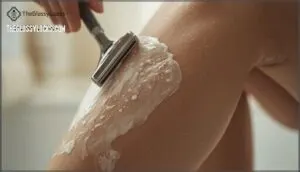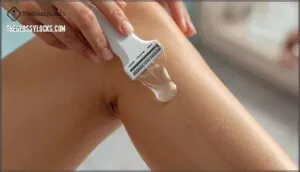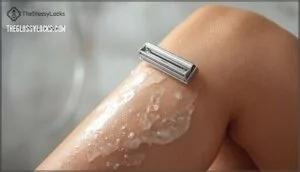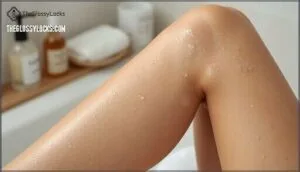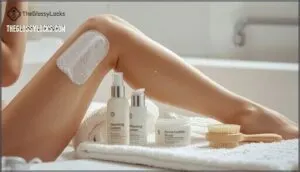This site is supported by our readers. We may earn a commission, at no cost to you, if you purchase through links.
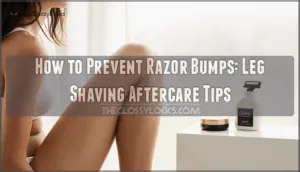 Razor bumps don’t appear because you shaved wrong—they show up because your hair decided to take a detour back into your skin. When a freshly cut hair curls beneath the surface instead of growing outward, your body treats it like an invader, triggering inflammation, redness, and those telltale bumps that can linger for days. This reaction happens more easily when dead skin cells pile up, blocking follicles and trapping hairs underneath.
Razor bumps don’t appear because you shaved wrong—they show up because your hair decided to take a detour back into your skin. When a freshly cut hair curls beneath the surface instead of growing outward, your body treats it like an invader, triggering inflammation, redness, and those telltale bumps that can linger for days. This reaction happens more easily when dead skin cells pile up, blocking follicles and trapping hairs underneath.
The good news is that leg shaving aftercare to prevent bumps doesn’t require expensive products or complicated routines. A few targeted steps immediately after you shave can stop ingrown hairs before they form, keeping your legs smooth without the irritation that follows.
Table Of Contents
Key Takeaways
- Razor bumps form when cut hair curls back into the skin rather than growing outward, triggering inflammation that your immune system responds to as if the trapped hair were a foreign invader.
- People with curly or coarse hair face 50 times higher risk of ingrown hairs because the curved hair shaft naturally curves back into skin after being cut with a sharp tip during shaving.
- Applying moisturizer within three to five minutes after shaving while skin is still damp locks in hydration and strengthens the skin barrier, preventing the dryness and inflammation that lead to razor bumps.
- Shaving with the grain using light pressure and avoiding multiple passes over the same area reduces irritation by preventing hairs from being cut below the skin surface where they can become trapped.
Causes of Razor Bumps After Shaving
Razor bumps develop when your hair doesn’t grow back the way it should after shaving. Understanding what causes them is the first step to keeping your legs smooth and irritation-free.
Let’s look at the main factors that trigger razor bumps and why some people are more prone to them than others.
How Ingrown Hairs Form
Razor bumps develop when hair re-enters the skin after shaving, a process that usually begins 2–3 days after hair removal. When you shave, you cut hairs at or below the skin’s surface, creating sharp tips. As new hair grows, it can curl back and penetrate the skin rather than emerging normally. Dead skin cell accumulation blocks follicles, trapping hair underneath. Your immune system then identifies this as a foreign object, triggering inflammation. This leads to a condition known as pseudofolliculitis barbae, which is quite common.
Here’s what happens:
- Hair is cut with a sharp tip during shaving
- Hair re-entry occurs as follicles become blocked by dead skin cells
- Skin renewal cycle traps newly growing hair beneath the surface
- Hair morphology and natural curl affect how easily hair re-enters follicles
- Your body’s inflammatory response creates the characteristic red bumps
Impact of Curly or Coarse Hair
If you have curly or coarse hair, your risk for razor bumps increases considerably. Curly hair is 50 times more likely than straight hair to become ingrown after shaving. That’s because the curved hair shaft naturally wants to curl back into the skin as it regrows. When you shave, you create sharp tips that make re-entry easier. Coarse hairs are thicker and stiffer, so they’re more likely to curl beneath the surface.
Curly hair is 50 times more likely than straight hair to become ingrown after shaving because its curved shaft naturally curls back into the skin
People with African, Middle Eastern, and Hispanic descent experience higher rates due to hair curvature and genetic predisposition. Without proper technique, you’re at risk for scarring and long-term skin damage. Shaving against the grain increases the risk of developing razor bumps.
Effects of Sensitive and Dry Skin
Your skin’s sensitivity and moisture level play a major role in how your body reacts to shaving, especially after dealing with the challenges that curly hair presents. Sensitive skin has a compromised skin barrier, making it more vulnerable to irritation from razor friction. Dry skin lacks the hydration importance needed to protect against damage, lowering your irritation threshold considerably.
When moisture is depleted, your skin struggles to heal efficiently, prolonging healing time after shaving. Product sensitivity further complicates matters—harsh gels or alcohol-containing lotions can trigger reactions. This combination accelerates razor bumps development.
Protecting your skin barrier through adequate hydration before and after shaving is essential for preventing razor bumps when you have sensitive or dry skin.
Risks of Shaving Too Closely or Frequently
When you shave too closely to the skin or too frequently, you’re basically setting the stage for ingrown hairs to develop and multiply. Each pass of the razor cuts hair below the skin surface, increasing hair damage and folliculitis risk.
Frequent shaving prevents your skin from recovering, compounding skin irritation and infection risk. This aggressive approach can also cause scarring potential and compromise your skin barrier, making razor bumps more likely and harder to prevent.
Pre-Shave Steps to Prevent Bumps
What you do before you shave matters just as much as what you do after. Taking a few simple preparatory steps can dramatically reduce your risk of developing razor bumps on your legs.
Let’s walk through the essential pre-shave strategies that’ll protect your skin and set you up for a smoother shave.
Importance of Skin Hydration
Dehydrated skin makes you more vulnerable to irritation, so rehydrating before you shave is one of the most effective defenses against razor bumps. Well-hydrated skin acts as a protective barrier, reducing inflammation and sensitivity during shaving.
Soak the area in warm water for three to five minutes to soften hair and skin, then apply a moisturizer or hydrating product with nourishing ingredients. This skin hydration and care routine gets your legs ready for a smoother shave while supporting long-term hydration benefits that extend well beyond a single session.
Benefits of Gentle Exfoliation
Exfoliating before you shave is like clearing away the obstacles that keep your razor from working properly—and it’s one of the most effective ways to stop ingrown hairs before they start. Gentle exfoliation removes dead skin cells that can trap hair beneath the surface, improving circulation to the area.
This dead skin removal improves product absorption when you apply shaving gel, giving your razor a clearer path. The result is smoother skin with fewer irritation points, making preshave exfoliation a critical step in your prevention routine.
Choosing The Right Razor and Blade
Your choice of razor matters more than most people realize, because the right blade can be the difference between smooth legs and a landscape of irritation. A sharp razor blade minimizes friction and reduces nicks that trigger bumps. Look for razors with three or more blades—they distribute pressure more evenly across your skin.
Consider your blade material too: stainless steel resists rust and maintains sharpness longer. For sensitive skin, comfortable grips give you better control, preventing the aggressive pressure that causes irritation.
Replace dull blades frequently; they tear hair rather than cut cleanly, setting the stage for ingrown hairs.
Shaving Creams and Gels for Protection
A good shaving cream or gel is like a protective barrier between your razor and skin—it’s not just a luxury, it’s a necessity for preventing bumps. The right product maintains moisture while you shave, reducing friction that leads to irritation and ingrown hairs.
- Cream ingredients like glycerin and aloe vera hydrate skin and calm sensitivity during shaving
- Gel benefits include better glide and visibility, helping you avoid multiple passes over the same area
- Application techniques matter—apply generously and let it soften your hair for 3–5 minutes before shaving
- Product comparison shows alcohol-free formulas work best for sensitive skin, preventing razor burn and bumps while moisturizing after shaving
Proper Shaving Techniques for Smooth Legs
How you shave matters just as much as what you use. The technique you choose can either protect your skin or set the stage for irritation and ingrown hairs.
Let’s walk through the specific methods that keep your legs smooth and bump-free.
Shaving in The Direction of Hair Growth
The direction you shave matters far more than most people realize—it’s the difference between smooth skin and a week of irritation. Shaving with the grain means following your individual hair growth patterns, not against them.
When you map the hair direction across your legs, you’ll notice it doesn’t grow uniformly everywhere. The angle your blade meets the skin makes a critical difference. Shaving with the grain reduces tension on hairs, preventing them from being cut below the skin surface where they curl back and cause ingrown hairs.
This consistent stroke direction protects your skin by avoiding the pulls and tugging that trigger irritation.
Using Light, Steady Strokes
Stroke pressure is your shaving technique’s silent saboteur. When you bear down hard on the razor, you’re actually working against yourself—forcing the blade closer to your skin and cutting hairs below the surface. That’s exactly what triggers ingrown hairs and razor bumps.
Let the razor’s weight do the work. Apply only light, steady pressure as you glide along the angle of hair growth. Your skin will thank you with smoother results and far less inflammation. This matters even more if you’ve got sensitive skin that already reacts strongly to shaving irritation.
Combine this gentle stroke pressure with directional shaving, and you’ve built a solid foundation for bump-free legs.
Avoiding Multiple Passes Over The Same Area
Each additional pass increases pressure application and stroke overlap, compounding irritation. One deliberate pass following hair growth with proper razor sharpness is sufficient.
Respect your skin’s sensitivity by resisting the urge to retrace areas—this prevents the weaving pattern that traps hairs beneath the surface, causing razor bumps and skin irritation. Your shaving technique matters more than repetition.
How Often to Shave for Healthier Skin
Shaving frequency matters just as much as technique—give your skin adequate recovery time between sessions to prevent razor bumps from becoming a chronic problem. How often you shave depends on several factors working together:
- Hair growth rate — Coarser, curlier hair regrows faster and requires less frequent shaving to avoid close cuts that trap hairs beneath skin
- Skin type — Sensitive skin needs 3–5 days between sessions; resilient skin may tolerate 2–3 day intervals
- Shaving habits — Aggressive technique demands longer recovery periods than gentle, single-pass shaving
- Seasonal factors — Winter requires less frequent shaving due to reduced sun exposure and clothing coverage
- Lifestyle demands — Athletic activity, sweating, and tight clothing increase irritation, so space out sessions accordingly
Most people find that shaving every 2–4 days strikes the right balance. When you space sessions properly and exfoliate between shaves, your skin stays smoother without the chronic irritation that fuels razor bumps. Listen to your skin—it’ll tell you when it needs a break.
Essential Aftercare to Avoid Razor Bumps
What you do after shaving matters just as much as the technique itself. The right aftercare stops razor bumps before they start by soothing irritation and protecting your skin barrier.
Here’s what works to keep your legs smooth and bump-free.
Applying Soothing Moisturizers
Right after you step out of the shower, your skin is primed and ready to absorb the care it needs most. Apply a moisturizer within three to five minutes while your skin is still slightly damp—this locks in hydration and strengthens your skin barrier.
Choose products with soothing ingredients like chamomile or vitamin E, especially if you have sensitive skin. Alcohol-free lotions or oils work best for postshave skin care, as they won’t irritate freshly shaved areas.
Consistent hydration after shaving prevents dryness and reduces inflammation, making razor bumps less likely to develop.
Cooling The Skin With Compresses
A cool compress works fast to calm inflammation and reduce redness after shaving. Apply it for five to ten minutes while your skin is still warm—this temperature contrast signals your body to dial down the irritation response.
Use a clean, soft cloth or compress, or even a cold spoon from your freezer. For sensitive skin, wrap the compress in thin fabric to avoid shocking your legs.
You can repeat this two to three times daily during the first day after shaving if irritation persists.
Using Alcohol-Free Lotions or Oils
Your skin needs moisture right after shaving, and alcohol-based products work against you by stripping away what little hydration your skin has left. Alcohol-free lotions and oils preserve your skin’s natural barrier while delivering essential hydration to prevent razor bumps.
Look for post-shave products labeled alcohol-free—they’re your best defense against irritation and ingrown hairs.
- Choose fragrance-free formulas to avoid irritating freshly shaved skin
- Apply to damp skin to lock in moisture more effectively
- Use oils like coconut or jojoba for sensitive skin prone to bumps
- Reapply nightly during the first few days after shaving for best healing
Ingredients That Calm and Protect Skin
Certain ingredients work harder than others to calm inflamed skin after shaving. Aloe vera reduces redness in most people within weeks, while witch hazel’s tannins naturally disinfect and tighten pores to lessen razor bumps.
Tea tree oil provides antimicrobial protection when diluted properly, and oatmeal soothes microtrauma effectively.
Botanical oils like jojoba and coconut oil repair your skin barrier while delivering anti-inflammatory relief—making them ideal choices for sensitive skin prone to irritation.
Home Remedies and Treatments for Irritation
If razor bumps have already formed, you don’t have to wait for them to clear on their own. There are several proven remedies and treatments that can speed up healing and reduce irritation.
Below are the most effective approaches, from gentle natural options to stronger topical solutions that can make a real difference.
Exfoliating to Release Ingrown Hairs
Dead skin cells and debris can trap hair beneath the surface, turning a close shave into a bump problem. Exfoliating before razor bumps develop is far more effective than treating them after.
Use a gentle exfoliating tool or face scrub two to three times weekly to remove dead skin and guide hairs outward. Chemical exfoliants like salicylic acid work well too.
After exfoliating, keep skin hydrated and avoid shaving immediately, giving your skin time to recover and reducing ingrown hair types that cause irritation.
Natural Soothers Like Aloe Vera and Coconut Oil
When inflammation and irritation set in after shaving, reaching for nature’s remedies can calm your skin faster than you’d expect. Aloe vera reduces inflammation while coconut oil provides deep hydration—both excellent for sensitive skin after shaving. These natural options work by soothing irritation without harsh chemicals.
- Aloe vera gel directly reduces redness and cools inflamed areas
- Coconut oil locks in moisture and strengthens your skin barrier
- DIY recipes combining aloe and oil create individual treatments for your skin type
- Oil combinations with witch hazel or tea tree add antiinflammatory benefits for razor burn relief
Topical Treatments (Salicylic Acid, Cortisone)
For tougher cases, topical treatments work like a targeted cleanup crew. Salicylic acid exfoliates trapped hairs and unclogs follicles, making it ideal for oily skin prone to razor bumps. Start with a 2% salicylic acid moisturizer daily after shaving.
Cortisone cream quickly calms acute inflammation but shouldn’t replace your regular skin care routine—limit use to four weeks to avoid thinning or pigment changes.
Combining both treatments alternately offers the best results for persistent bumps.
When to Pause Shaving or Seek Medical Advice
Persistent bumps that don’t fade within a week signal it’s time to give your razor a break. Watch for infection signs like pus, severe pain, or spreading redness—these indicate a bacterial infection requiring antibiotics from a dermatologist.
Scarring concerns or recurring skin infections also warrant professional evaluation. Meanwhile, consider alternative options like waxing to let your skin heal properly.
Frequently Asked Questions (FAQs)
Can razor bumps cause permanent scarring on legs?
Repeated trauma from picking or scratching razor bumps can lead to scarring on legs. Scarring risk factors include skin irritation severity, wound healing complications, and infection. Proper scarring prevention and treatments minimize long-term effects.
How long do razor bumps typically last?
Most razor bumps clear up within one to two weeks without treatment. However, healing timeframes vary based on factors like skin irritation severity, inflammation levels, and whether you continue shaving.
Treatment impact can speed recovery, while scarring potential increases with persistent itchy skin or repeated trauma.
Are electric razors better for preventing bumps?
Ironically, electric razors don’t guarantee bump-free shaving, but they can help. Foil and rotary types reduce blade contact with skin, lowering ingrown hair risk. Wet/dry options allow gentler shaving techniques, preventing razor bumps better than traditional methods.
Can you shave with razor bumps present?
Shaving over existing razor bumps greatly increases the risk of shaving bumps. The aggravation potential is high, as the razor can worsen skin irritation and interfere with healing.
Infection likelihood also rises. Consider alternative options like waxing until your skin recovers completely.
Do certain fabrics worsen razor bump irritation?
Like sandpaper on sunburn, synthetic fabrics and tight clothing can worsen razor bumps through friction. Post-shave, your legs need breathable materials that reduce skin irritation and allow proper aftercare healing.
Conclusion
What’s the point of smooth legs if they’re covered in angry red bumps two days later? The difference between irritation-free skin and a week of discomfort comes down to what you do in the minutes after your razor touches your leg.
Effective leg shaving aftercare to prevent bumps isn’t about adding more steps—it’s about doing the right ones. Moisturize immediately, skip harsh products, and give your skin time to recover between shaves. Your legs will thank you with the smoothness you were aiming for all along.
- https://www.aad.org/public/everyday-care/skin-care-basics/hair/razor-bump-remedies
- https://pmc.ncbi.nlm.nih.gov/articles/PMC6585396/
- https://www.ncbi.nlm.nih.gov/pmc/articles/PMC6585396/
- https://www.massgeneral.org/condition/ingrown-hairs
- https://www.goodrx.com/health-topic/dermatology/how-to-get-rid-of-razor-bumps-fast


